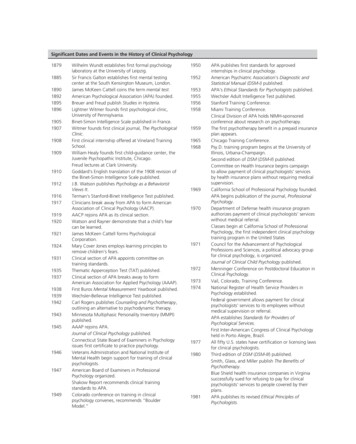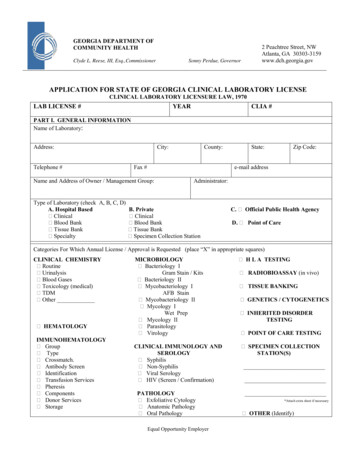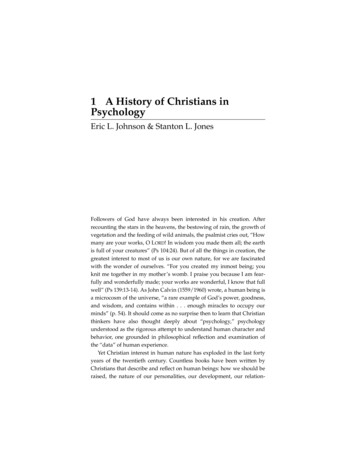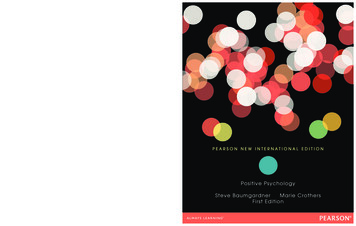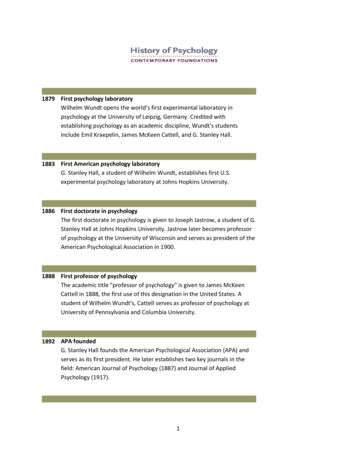
Transcription
1879 First psychology laboratoryWilhelm Wundt opens the world’s first experimental laboratory inpsychology at the University of Leipzig, Germany. Credited withestablishing psychology as an academic discipline, Wundt's studentsinclude Emil Kraepelin, James McKeen Cattell, and G. Stanley Hall.1883 First American psychology laboratoryG. Stanley Hall, a student of Wilhelm Wundt, establishes first U.S.experimental psychology laboratory at Johns Hopkins University.1886 First doctorate in psychologyThe first doctorate in psychology is given to Joseph Jastrow, a student of G.Stanley Hall at Johns Hopkins University. Jastrow later becomes professorof psychology at the University of Wisconsin and serves as president of theAmerican Psychological Association in 1900.1888 First professor of psychologyThe academic title "professor of psychology" is given to James McKeenCattell in 1888, the first use of this designation in the United States. Astudent of Wilhelm Wundt's, Cattell serves as professor of psychology atUniversity of Pennsylvania and Columbia University.1892 APA foundedG. Stanley Hall founds the American Psychological Association (APA) andserves as its first president. He later establishes two key journals in thefield: American Journal of Psychology (1887) and Journal of AppliedPsychology (1917).1
1896 FunctionalismFunctionalism, an early school of psychology, focuses on the acts andfunctions of the mind rather than its internal contents. Its most prominentAmerican advocates are William James and John Dewey, whose 1896article "The Reflex Arc Concept in Psychology" promotes functionalism.PsychoanalysisThe founder of psychoanalysis, Sigmund Freud, introduces the term in ascholarly paper. Freud's psychoanalytic approach asserts that people aremotivated by powerful, unconscious drives and conflicts. He develops aninfluential therapy based on this assertion, using free association anddream analysis.StructuralismEdward B. Titchener, a leading proponent of structuralism, publishes hisOutline of Psychology. Structuralism is the view that all mental experiencecan be understood as a combination of simple elements or events. Thisapproach focuses on the contents of the mind, contrasting withfunctionalism.First psychology clinicAfter heading a laboratory at University of Pennsylvania, Lightner Witmeropens world's first psychological clinic to patients, shifting his focus fromexperimental work to practical application of his findings.1900 Interpretation of DreamsSigmund Freud introduces his theory of psychoanalysis in TheInterpretation of Dreams, the first of 24 books he would write exploringsuch topics as the unconscious, techniques of free association, andsexuality as a driving force in human psychology.1901 Manual of Experimental PsychologyWith publication of the Manual of Experimental Psychology, EdwardBradford Titchener introduces structuralism to the United States.Structuralism, an approach which seeks to identify the basic elements ofconsciousness, fades after Titchener's death in 1927.2
1904 First woman president of the APAMary Calkins is elected president of the APA. Calkins, a professor andresearcher at Wellesley College, studied with William James at HarvardUniversity, but Harvard denied her a Ph.D. because of her gender.1905 IQ tests developedUsing standardized tests, Alfred Binet and Theodore Simon develop a scaleof general intelligence on the basis of mental age. Later researchers refinethis work into the concept of intelligence quotient; IQ, mental age overphysical age. From their beginning, such tests' accuracy and fairness arechallenged.1908 A Mind That Found ItselfClifford Beers publishes A Mind That Found Itself, detailing his experiencesas a patient in 19th-century mental asylums. Calling for more humanetreatment of patients and better education about mental illness for thegeneral population, the book inspires the mental hygiene movement in theUnited States.1909 Psychoanalysts visit Clark UniversitySigmund Freud and Carl Jung visit the United States for a PsychoanalysisSymposium at Clark University organized by G. Stanley Hall. At thesymposium, Freud gives his only speech in the United States.1913 BehaviorismJohn B. Watson publishes "Psychology as Behavior," launchingbehaviorism. In contrast to psychoanalysis, behaviorism focuses onobservable and measurable behavior.1917 Army intelligence tests implementedStandardized intelligence and aptitude tests are administered to twomillion U. S. soldiers during WWI. Soon after, such tests are used in all U.S.armed forces branches and in many areas of civilian life, includingacademic and work settings.3
1920 First African American doctorate in psychologyFrancis Cecil Sumner earns a Ph.D. in psychology under G. Stanley Hall atClark University. Sumner later serves as chair of the Howard Universitypsychology department.The Child's Conception of the WorldSwiss psychologist Jean Piaget publishes The Child's Conception of theWorld, prompting the study of cognition in the developing child.1921 Rorschach test createdSwiss psychiatrist Hermann Rorschach devises a personality test based onpatients' interpretations of inkblots.1925 Menninger Clinic foundedCharles Frederick Menninger and his sons Karl Augustus and William Clairfound The Menninger Clinic in Topeka, Kansas. They take a compassionateapproach to the treatment of mental illness, emphasizing bothpsychological and psychiatric disciplines.1927 Menninger Clinic foundedFirst Nobel Prize for psychological research1929 Electroencephalogram inventedPsychiatrist Hans Berger invents the electroencephalogram and tests it onhis son. The device graphs the electrical activity of the brain by means ofelectrodes attached to the head.1933 Nazi persecution of psychologistsAfter the Nazi party gains control of the government in Germany, scholarsand researchers in psychology and psychiatry are persecuted. Many,including Freud, whose books are banned and burned in public rallies,move to Britain or the United States.4
1935 Alcoholics AnonymousAlcoholics Anonymous (AA) is founded by Bob Smith of Akron, Ohio. AA'sgroup meetings format and 12-step program become the model for manyother mutual-support therapeutic groups.Gestalt psychologyKurt Koffka, a founder of the movement, publishes Principles of GestaltPsychology in 1935. Gestalt (German for "whole" or "essence") psychologyasserts that psychological phenomena must be viewed not as individualelements but as a coherent whole.1936 First lobotomy in the United StatesWalter Freeman performs first frontal lobotomy in the United States atGeorge Washington University in Washington, D.C. By 1951, more than18,000 such operations have been performed. The procedure, intended torelieve severe and debilitating psychosis, is controversial.1937 The Neurotic Personality of Our TimePsychologist Karen Horney publishes The Neurotic Personality of Our Time.Horney goes on to challenge many of Freud's theories, as have many laterpsychologists and scholars. Specifically, she questions Freud's theories onthe Oedipal Complex and castration anxiety.1938 The Behavior of OrganismsB.F. Skinner publishes The Behavior of Organisms, introducing the conceptof operant conditioning. The work draws widespread attention tobehaviorism and inspires laboratory research on conditioning.Electroconvulsive therapy (ECT) begunItalian psychiatrist and neuropathologist Ugo Cerletti and his associatestreat human patients with electrical shocks to alleviate schizophrenia andpsychosis. ECT, while controversial, is proven effective in some cases and isstill in use in 2019.5
1946 The Psychoanalytic Treatment of ChildrenAnna Freud publishes The Psychoanalytic Treatment of Children,introducing basic concepts in the theory and practice of childpsychoanalysis.National Mental Health Act PassedU.S. President Harry Truman signs the National Mental Health Act,providing generous funding for psychiatric education and research for thefirst time in U.S. history. This act leads to the creation in 1949 of theNational Institute of Mental Health (NIMH).1951 First drug to treat depressionStudies are published reporting that the drug imipramine may be able tolessen depression. Eight years later, the FDA approves its use in the UnitedStates under the name Tofranil.1952 Thorazine testedThe anti-psychotic drug chlorpromazine (known as Thorazine) is tested ona patient in a Paris military hospital. Approved for use in the United Statesin 1954, it becomes widely prescribed.1953 APA Ethical StandardsThe American Psychological Association publishes the first editionof Ethical Standards of Psychologists. The document undergoes continuousreview and is now known as APA's Ethical Principles of Psychologists andCode of Conduct.1954 Epilepsy and the Functional Anatomy.In Epilepsy and the Functional Anatomy of the Human Brain, neurosurgeonWilder G. Penfield publishes results from his study of the neurology ofepilepsy. His mapping of the brain's cortex sets a precedent for the brainimaging techniques that become critical to biopsychology and cognitiveneuroscience.The Nature of PrejudiceSocial Psychologist Gordon Allport publishes The Nature of Prejudice,6
which draws on various approaches in psychology to examine prejudicethrough different lenses. It is widely read by the general public andinfluential in establishing psychology's usefulness in understanding socialissues.BiopsychologyIn his studies of epilepsy, neuroscientist Wilder G. Penfield begins touncover the relationship between chemical activity in the brain andpsychological phenomena. His findings set the stage for widespreadresearch on the biological role in psychological phenomena.PsychopharmacologyThe development of psychoactive drugs in the 1950s and their approval bythe FDA initiates a new form of treatment for mental illness. Among thefirst such drugs is Doriden, also known as Rorer, an anti-anxietymedication approved in 1954.Humanistic PsychologyIn the wake of psychoanalysis and behaviorism, humanistic psychologyemerges as the "third force" in psychology. Led by Carl Rogers andAbraham Maslow, who publishes Motivation and Personality in 1954, thisapproach centers on the conscious mind, free will, human dignity, and thecapacity for self-actualization.1956 Cognitive psychologyInspired by work in mathematics and other disciplines, psychologists beginto focus on cognitive states and processes. George A. Miller's 1956 article"The Magical Number Seven, Plus or Minus Two" on informationprocessing is an early application of the cognitive approach.1957 Syntactic StructuresNoam Chomsky publishes Syntactic Structures, marking a majoradvancement in the study of linguistics. The book helps spawn the field ofpsycholinguistics, the psychology of language.7
1960 FDA approves LibriumThe FDA approves the use of chlordiazepoxide (known as Librium) fortreatment of non-psychotic anxiety in 1960. A similar drug, diazepam(Valium), is approved in 1963.1963 Community Mental Health Centers Act passedU.S. President John F. Kennedy calls for and later signs the CommunityMental Health Centers Act, which mandates the construction ofcommunity facilities instead of large, regional mental hospitals. Congressends support for the program in 1981, reducing overall funds and foldingthem into a mental health block-grant program.1964 First National Medal of Science to psychologistNeal E. Miller receives the National Medal of Science, the highest scientifichonor given in the United States, for his studies of motivation andlearning. He is the first psychologist to be awarded this honor.1964 FDA approves LithiumThe FDA approves lithium carbonate to treat patients with bipolar mooddisorders. It is marketed under the trade names Eskalith, Lithonate, andLithane.1973 Homosexuality removed from DSMAfter intense debate, the American Psychiatric Association removeshomosexuality from the Diagnostic and Statistical Manual of MentalDisorders (DSM). The widely used reference manual is revised to state thatsexual orientation "does not necessarily constitute a psychiatric disorder."1974 PET scanner testedA new brain scanning technique, Positron Emission Tomography (PET), istested. By tracing chemical markers, PET maps brain function in moredetail than earlier techniques.8
1976Evolutionary psychologyRichard Dawkins publishes The Selfish Gene, which begins to popularizethe idea of evolutionary psychology. This approach applies principles fromevolutionary biology to the structure and function of the human brain. Itoffers new ways of looking at social phenomena such as aggression andsexual behavior.The Selfish GeneRichard Dawkins publishes The Selfish Gene, a work which shifts focus fromthe individual animal as the unit of evolution to individual genesthemselves. The text popularizes the field of evolutionary psychology, inwhich knowledge and principles from evolutionary biology are applied inresearch on human brain structure.1979 Standardized IQ tests found discriminatoryThe U.S. District Court finds the use of standardized IQ tests in Californiapublic schools illegal. The decision in the case, Larry P. v. Wilson Riles,upholds the plaintiff's position that the tests discriminate against AfricanAmerican students.1981 AIDS and HIV first diagnosedThe epidemic of acquired immunodeficiency syndrome (AIDS) and humanimmunodeficiency virus (HIV) infection presents mental healthprofessionals with challenges ranging from at-risk patients' anxiety anddepression to AIDS-related dementia.1984 Insanity Defense Reform Act passedU.S. Congress revises federal law on the insanity defense, partly inresponse to the acquittal of John Hinckley, Jr. of charges of attemptedassassination after he had shot President Ronald Reagan. The act placesburden of proof for the insanity defense on the defendant.1987 Homeless Assistance Act passedThe Stewart B. McKinney Homeless Assistance Act provides the firstfederal funds allocated specifically for the homeless population. The act9
includes provisions for mental health services, and responds, in part, topsychological studies on homelessness and mental disorders.Prozac, Paxil, and Zoloft made availableThe FDA approves the new anti-depressant medication fluoxetine,(Prozac). The drug, and other similar medications, acts onneurotransmitters, specifically, serotonin. It is widely prescribed andattracts attention and debate.1990 Cultural psychologyIn Acts of Meaning, Four Lectures on Mind and Culture, Jerome Brunerhelps formulate cultural psychology, an approach drawing on philosophy,linguistics, and anthropology. Refined and expanded by Hazel Markus andother researchers, cultural psychology focuses on the influences andrelationship among mind, cultural community and behavior.2000 Sequencing of the Human GenomeSixteen public research institutions around the world complete a "workingdraft" mapping of the human genetic code, providing a research basis for anew understanding of human development and disease. A similar,privately funded, project is currently underway.DSM on PDAThe latest revision of the Diagnostic Statistical Manual of Mental Disorders(DSM) is published in a version for personal digital assistants (PDAs). Themanual, first published in 1954, outlines prevalence, diagnosis, andtreatment of mental disorders. Only 132 pages on first printing, in 2000 itwas 980 pages.10
First psychology laboratory Wilhelm Wundt opens the world's first experimental laboratory in psychology at the University of Leipzig, Germany. Credited with establishing psychology as an academic discipline, Wundt's students include Emil Kraepelin, James McKeen Cattell, and G. Stanley Hall. 1883 First American psychology laboratory




